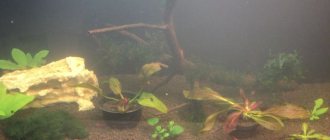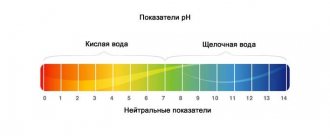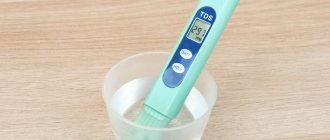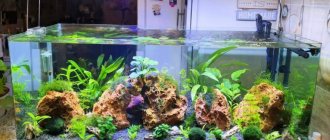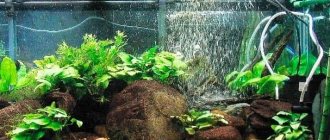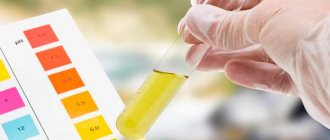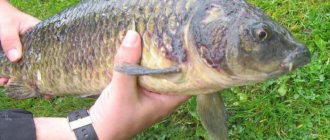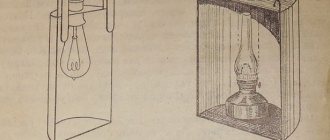Beginners in the aquarium hobby confuse algae with plants, although the difference between these concepts is enormous. Higher plants decorate the aquarium and create the necessary conditions for fish to live. Algae are weedy organisms that attack higher plants and, in some cases, aquarium fish. Many aquarists are faced with the appearance of a green coating on glass, soil and decorations. Unwanted greenery in the aquarium spoils the impression of the underwater world.
Reasons: why the water in the aquarium blooms
Green water in the aquarium, what should I do? Beginning aquarium professionals do not understand the difference between “algae” and “plant”. Therefore, first you need to understand these names.
Underwater plants are multicellular higher representatives of the underwater world. Includes: moss, moss, underwater fern and more. The presence of plants in an artificial pond helps fight the formation of algae and serves as an additional filter. You cannot plant many of these “filters”. This will cause stagnation in the water. When choosing greens, specialist advice is required. For some fish it is food, and for others it is poison.
Algae are single or multicellular lower plants of the underwater kingdom. “Green parasites” form a coating inside the tank, emit an unpleasant odor and spoil the whole picture. They cloud and spoil the quality of water, “strangling” planted plants. Moreover, not all representatives are harmless. Many species pose a threat to all life in the underwater world.
So why does the water in the aquarium turn green?
Compsopogon, aka “Blackbeard”
Any algae looks unsightly, but black beard is the most unpleasant. Her appearance resembles matted gray-black hair. It settles on plants, blocking access of light and heat to plant tissues. Because of this, they are destroyed. If measures are not taken in time, then the aquarium flora can die quite quickly. Also, compsopogon settles on the ground, artificial plants, on the walls of the aquarium and on filters. In a word, wherever organic substances and mechanical suspension necessary for its life are retained.
Fighting algae by removing it from its surface is not enough. If the cause of its appearance is not eliminated, the fight will become useless.
“Black beard” is formed as a result of the accumulation of organic matter in water:
- Excess feed
- Waste products of fish,
- The remains of fish after they die.
Corrective measures:
- Keeping the aquarium clean
- Regulation of diet . Do not overfeed the fish. A lack of feed is better than its excess, which systematically settles on the ground.
- Timely water replacement.
- Chemical products that have gained great popularity today. If you follow the manufacturers’ recommendations, you can quickly and efficiently get rid of the unwanted “invader.” For example, glutaraldehyde, Sidex, effectively deals with Blackbeard . The drug not only destroys harmful algae, but also promotes the synthesis of carbon dioxide necessary for the normal development of aquatic plants.
- Compsopogon, aka “Blackbeard”.
Euglena viridis or green euglena
This is the simplest single-celled organism with which all lovers of the underwater world are familiar. Euglena viridis creates a film on the water surface. If the light source does not provide enough light, the algae begins to turn pale. Euglena green begins to actively reproduce under the following conditions:
- A large amount of light;
- The presence of a large amount of organic waste in the water (remains of fish food, waste, etc.). In other words, the equipment is not designed for such amounts of waste and debris. For high-quality cleaning, you need to completely empty the container, clean all the gravel, wash the walls and decor by hand, change the water on time and look for the root cause of the contamination.
- The filtration system is not working properly.
Green Euglena appears and begins to reproduce in the water almost immediately. Yesterday everything was fine, but today the water is already cloudy and covered with a film.
Why is the aquarium blooming?
The water in the aquarium turns green because:
- Cleaning too often;
- Poor equipment operation (weak compressor, stagnant water);
- Improper thermoregulation;
- Excess of planted underwater plants;
- Violation of daylight hours.
It is necessary to feed the fish as needed. All food that has not been eaten begins to decompose and rot at the bottom.
Signs
Signs of ecosystem disturbance:
- cloudiness of water;
- change in color of the liquid to green and brown;
- the scenery, water surface and soil are covered with a green film or coating;
- increased content of phosphorus and nitrates;
- abundant appearance of green plaque in the aquarium.
Plaque in small quantities is considered normal. Don't be alarmed if you notice a few green dots in your aquarium. Observe the flora; if the glass becomes more green and the water becomes cloudy, this should be a cause for concern.
Why does the aquarium turn green and how to deal with green water?
There are several options for restoring fluid in an artificial reservoir.
Natural Cleansing
You can use the services of daphnia or other creatures that prefer to eat algae (catfish, platies, and others) or snails.
Also, to get rid of water blooms, underwater plants are used, such as hornwort and bladderwort. Their rapid growth neutralizes the amount of nitrogen in the water.
Nitrogen is a promoter of liquid bloom. In 1 week, the hornwort grows up to one and a half meters. Before planting plants, it is necessary to update half the volume of the tank and remove humus from the bottom. You need to choose plants in such a way that underwater inhabitants can get along with them.
List of the most popular assistants:
- Crossocheilus oblongus (Siamese algae eater).
- Otocinclus (otocinclus). Fish that feed specifically on green scourge. Capable of dealing with many types of algae.
- Ancistrus or ancistrus catfish. You need to be careful with these fish, because catfish also like to gnaw on plants.
- Clams, shrimp and snails. They clean the walls perfectly.
Artificial cleaning
Why does the aquarium turn green? The first step is to check all the equipment. The problem may lie in a malfunction of the equipment. It may be worth replacing the lighting fixtures. Equipment requirements:
- Ultraviolet sterilizer that prevents cell division of green euglena and other plant pests;
- Diatom filter. This is a filtration device consisting of two elements: a filter bag and a porous core. It ensures water purification from floating microorganisms.
Chemical cleaning
What to do if the water in the aquarium turns green? All equipment also requires assistance in operation. For example, the operation of the filter can be made more productive if it is equipped with carbon (granules). The equipment is cleaned 4 times a month.
Interesting observation! 3 ml of streptomycin powder per 1 liter of water neutralizes the reproduction of unicellular lower organisms.
The use of the coagulant "Hyacinth" (created to purify drinking water) helps to get rid of all harmful impurities.
Tablets and other means of getting rid of the problem
Nowadays, pet stores sell various products to combat the bloom of aquarium water . It is only recommended to use them in particularly difficult cases, following the attached instructions.
The most effective include:
TetraAqua AlgoStop depot is a drug in the form of dissolvable tablets. It protects the fresh aquatic environment from the development of all kinds of algae. Safe for fish and plants. Price from - 440 rub.- Tetra Algizit is a tablet product for controlling algae in aquariums. Does not have a destructive effect on other vegetation and living world. Ten tablets are enough to disinfect 200 liters. Manufacturer – Germany. Price - from 300 rub.
- Dajana Algicid is an effective Czech remedy for water blooms, produced in 100 ml bottles. One package is designed to process a volume of 500 liters. The optimal dosage is 5:25.
- JBL Algol is a product from a German manufacturer to suppress the growth of algae. Sold in liquid form - the package contains 100 ml. It contains no copper and is therefore harmless to living aquarium inhabitants. The effect of the drug appears immediately after application, and after a few days. One bottle is enough for 400 liters of water.
- Aquarium Pharmaceuticals Algaefix is an effective product indicated for removing algae deposits from the interior surfaces of aquariums. Also used for water purification. Does not harm fish or vegetation. Consumption – 1 ml per 40 liters of aquarium water. One bottle is enough to treat 1400 liter volume. Price from - 350 rub.
- Aquastop is a domestic product that can destroy blue-green and other algae. Does not harm fish or plants. Its action is based on the ability to reduce the pH of water, thereby creating an unfavorable environment for the proliferation of phytoplankton. 100 ml is enough to treat a 200th aquarium with water. Price from - 40 rub.
When flowering is just beginning, it is recommended to resort to the following means:
- streptomycin - taken at the rate of 3 mg per liter of water;
- hyacinth - added to the aquarium in a ratio of 1:10;
- erythromycin is an antibiotic, which is added at the rate of 250 mg per 100 liters.
What to do with underwater pets?
Deterioration in water quality can destroy the entire ecosystem of the reservoir. The steps taken to clean an aquarium should be to improve the situation, and not the other way around:
- All healthy inhabitants need to be transplanted into another container with water of similar composition;
- Prepare water for plant replanting (methylene blue solution according to instructions);
- Check the quality of the soil and replace if necessary;
- Heat treat all underwater decorations.
With neutral control of green pests, the fish can be left alone. The main thing is not to forget to change at least 1/3 of the water in the container.
Preventive measures
If you follow simple rules, you can avoid the hassle of dealing with algae.
Aquarium. It is not recommended to place the container in direct sunlight, as it will quickly turn green. It is better to lay the soil with an inclination towards the front glass. This will make it easier to clear away debris.
Lighting. When equipping a new aquarium, you need to control the daylight hours. At first it is better to limit yourself to 4-5 hours. Increase the time - gradually, gradually bringing it up to 10 hours.
Attention! The lighting is exclusively artificial. Fluorescent lamp up to 0.5 watt per 1 liter of liquid.
Access to oxygen from outside and light requires adjustment. These simple steps will save your budget and time spent on dealing with green pests.
Blooming water in an aquarium lies in a violation of the biobalance. Pros know that every tank already contains spores of “pests,” fungi and bacteria. Otherwise, the aquarium is not a completely artificial tank. This is an organism that lives the same way as all creatures. When at least one link falls out of the built system, flowering processes begin.
An algae attack is a direct indicator of a lack of balance.
Common types of algae
There are many varieties of these plants. There are about 30 thousand species. The most common are brown, red and blue-green aquatic organisms.
Brown or diatoms
These are the most common and simple organisms. They are a brown coating that covers all surfaces in the tank. The outer shell is very hard and impregnated with silicon, so in water with a high silicate content they appear very quickly. The hard shell is not able to grow for a long time, so when they reproduce, they become smaller. They often appear in beginners or in new aquariums.
The reason for their occurrence is a lack of light. They give the water a dirty look, shade the leaves of plants, and limit their nutrition. Plants that love light and become covered with these algae are usually in very poor condition or die completely.
These organisms can be combated using mechanical methods. But the easiest way is to increase the light intensity and they will disappear on their own.
The cause of diatoms is a lack of light.
Red or purple
This is a whole group of lower plants. The most famous of them are the black beard and the Vietnamese woman. Black beard consists of threads up to 10 cm long. Vietnamese - small bushes up to 2 cm. Both types are dirty green, almost black. These organisms are very tenacious and difficult to remove. Their large number and sudden appearance are very dangerous for the inhabitants of the aquarium.
Purple fish multiply very quickly and in a short time can spread throughout the entire aquarium. They infect plants by settling on the tips of leaves. Then they spread to stems, stones, and snags. Massive development of algae can lead to the death of the plant. The appearance of purple spots is a sign that there is an excess of organic waste in the aquarium and a violation of the lighting regime. Overpopulation of the aquarium also leads to the rapid reproduction of these organisms.
The growth of purple spots can be caused by fast currents . Red algae in the aquarium multiply on the surface of the filters. They appear on decorations with a high calcium content: figurines, marble chips, corals, shells.
When getting rid of scarlet, you must first of all eliminate the movement of water, thereby worsening its nutrition. If possible, reduce the number of fish. Filtration, soil cleaning and water changes reduce the growth of scarlet.
Blue-green bacteria
This group of organisms are bacteria, which is how they differ from other algae. These are one of the most dangerous guests of aquariums, as they release toxins into the water. In addition, they use nitrogen for their vital functions, which leads to the accumulation of nitrates in the water. They are a green slippery film that covers the soil, plants and all aquarium equipment. These organisms have an unpleasant odor.
The appearance of blue-green plants is primarily due to the excess content of organic substances in water, which arise as a result of the decomposition of food residues. Low oxygen content in water also promotes the development of organisms. If blue-green algae appears in an aquarium, this means that a general disturbance of the ecosystem has occurred.
The fight against these bacteria must be comprehensive . It is necessary to combine mechanical and biochemical methods. You should regularly clean the walls of the aquarium, plants and decor from plaque. It is necessary to darken the aquarium, remove fish and valuable plant species. Do not filter until the bacteria disappear.
The biochemical method consists of dissolving antibiotics or antiseptics in water. After the plants disappear, you need to thoroughly rinse the plants, decor and the aquarium itself.
The appearance of blue-green plants is primarily due to the excess content of organic substances in water, which arise as a result of the decomposition of food residues.
Proper aquarium care
Professionals in this field know that Euglena viridis reproduces systematically. To do this, you should monitor the level of nitrogen in the water when you first start up the equipment.
Attention! If you have an old aquarium, it is better to take water and cleaning equipment from there. Shortened daylight hours (up to 2 hours per 24 hours, over 30 days) will help regulate nitrogen levels.
With constant monitoring of the devices, the aquarium will be fine. If the aquarium is blooming, it is recommended to check the fish feeding schedule.
